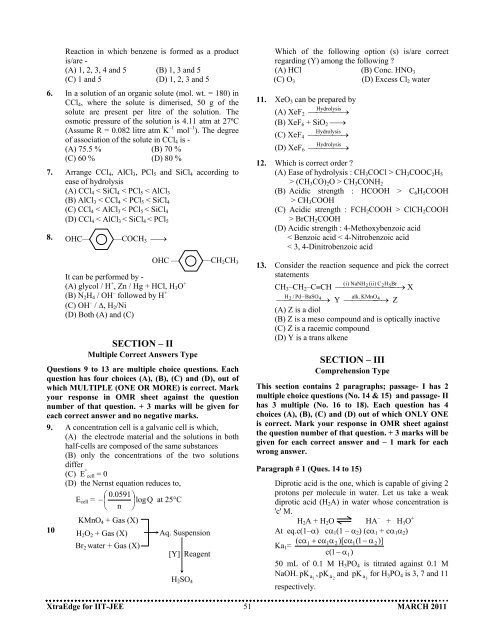March 2011 - Career Point
March 2011 - Career Point
March 2011 - Career Point
You also want an ePaper? Increase the reach of your titles
YUMPU automatically turns print PDFs into web optimized ePapers that Google loves.
Reaction in which benzene is formed as a product<br />
is/are -<br />
(A) 1, 2, 3, 4 and 5 (B) 1, 3 and 5<br />
(C) 1 and 5 (D) 1, 2, 3 and 5<br />
6. In a solution of an organic solute (mol. wt. = 180) in<br />
CCl 4 , where the solute is dimerised, 50 g of the<br />
solute are present per litre of the solution. The<br />
osmotic pressure of the solution is 4.11 atm at 27ºC<br />
(Assume R = 0.082 litre atm K –1 mol –1 ). The degree<br />
of association of the solute in CCl 4 is -<br />
(A) 75.5 % (B) 70 %<br />
(C) 60 % (D) 80 %<br />
7. Arrange CCl 4 , AlCl 3 , PCl 5 and SiCl 4 according to<br />
ease of hydrolysis<br />
(A) CCl 4 < SiCl 4 < PCl 5 < AlCl 3<br />
(B) AlCl 3 < CCl 4 < PCl 5 < SiCl 4<br />
(C) CCl 4 < AlCl 3 < PCl 5 < SiCl 4<br />
(D) CCl 4 < AlCl 3 < SiCl 4 < PCl 5<br />
8. OHC–– ––COCH 3 ⎯→<br />
It can be performed by -<br />
(A) glycol / H + , Zn / Hg + HCl, H 3 O +<br />
(B) N 2 H 4 / OH – followed by H +<br />
(C) OH – / ∆, H 2 /Ni<br />
(D) Both (A) and (C)<br />
OHC –– ––CH 2 CH 3<br />
SECTION – II<br />
Multiple Correct Answers Type<br />
Questions 9 to 13 are multiple choice questions. Each<br />
question has four choices (A), (B), (C) and (D), out of<br />
which MULTIPLE (ONE OR MORE) is correct. Mark<br />
your response in OMR sheet against the question<br />
number of that question. + 3 marks will be given for<br />
each correct answer and no negative marks.<br />
9. A concentration cell is a galvanic cell is which,<br />
(A) the electrode material and the solutions in both<br />
half-cells are composed of the same substances<br />
(B) only the concentrations of the two solutions<br />
differ<br />
(C) E ° cell = 0<br />
(D) the Nernst equation reduces to,<br />
⎛ 0.0591⎞<br />
E cell = − ⎜ ⎟logQ<br />
at 25°C<br />
⎝ n ⎠<br />
10<br />
KMnO 4 + Gas (X)<br />
H 2 O 2 + Gas (X)<br />
Br 2 water + Gas (X)<br />
Aq. Suspension<br />
[Y]<br />
H 2 SO 4<br />
Reagent<br />
Which of the following option (s) is/are correct<br />
regarding (Y) among the following ?<br />
(A) HCl (B) Conc. HNO 3<br />
(C) O 3<br />
(D) Excess Cl 2 water<br />
11. XeO 3 can be prepared by<br />
(A) XeF 2 ⎯ Hydrolysis ⎯⎯⎯→<br />
(B) XeF 6 + SiO 2 ⎯→<br />
(C) XeF 4 ⎯ Hydrolysis ⎯⎯⎯→<br />
(D) XeF 6 ⎯ Hydrolysis ⎯⎯⎯→<br />
12. Which is correct order ?<br />
(A) Ease of hydrolysis : CH 3 COCl > CH 3 COOC 2 H 5<br />
> (CH 3 CO) 2 O > CH 3 CONH 2<br />
(B) Acidic strength : HCOOH > C 6 H 5 COOH<br />
> CH 3 COOH<br />
(C) Acidic strength : FCH 2 COOH > ClCH 2 COOH<br />
> BrCH 2 COOH<br />
(D) Acidic strength : 4-Methoxybenzoic acid<br />
< Benzoic acid < 4-Nitrobenzoic acid<br />
< 3, 4-Dinitrobenzoic acid<br />
13. Consider the reaction sequence and pick the correct<br />
statements<br />
( i) NaNH2 (ii) C2H5<br />
CH 3 –CH 2 –C≡CH ⎯⎯⎯⎯⎯⎯⎯⎯<br />
Br →X<br />
H2 / Pd − BaSO 4<br />
alk. KMnO<br />
4<br />
⎯⎯⎯⎯⎯⎯<br />
→ Y ⎯⎯<br />
⎯⎯⎯<br />
→ Z<br />
(A) Z is a diol<br />
(B) Z is a meso compound and is optically inactive<br />
(C) Z is a racemic compound<br />
(D) Y is a trans alkene<br />
SECTION – III<br />
Comprehension Type<br />
This section contains 2 paragraphs; passage- I has 2<br />
multiple choice questions (No. 14 & 15) and passage- II<br />
has 3 multiple (No. 16 to 18). Each question has 4<br />
choices (A), (B), (C) and (D) out of which ONLY ONE<br />
is correct. Mark your response in OMR sheet against<br />
the question number of that question. + 3 marks will be<br />
given for each correct answer and – 1 mark for each<br />
wrong answer.<br />
Paragraph # 1 (Ques. 14 to 15)<br />
Diprotic acid is the one, which is capable of giving 2<br />
protons per molecule in water. Let us take a weak<br />
diprotic acid (H 2 A) in water whose concentration is<br />
'c' M.<br />
H 2 A + H 2 O HA – + H 3 O +<br />
At eq.c(1–α) cα 1 (1 – α 2 ) (cα 1 + cα 1 α 2 )<br />
(cα1<br />
+ cα1α<br />
2)[cα1(1<br />
− α2)]<br />
Ka 1 =<br />
c(1 − α1)<br />
50 mL of 0.1 M H 3 PO 4 is titrated against 0.1 M<br />
NaOH. pKa<br />
, pK<br />
1 a 2<br />
and pKa 3<br />
for H 3 PO 4 is 3, 7 and 11<br />
respectively.<br />
XtraEdge for IIT-JEE 51<br />
MARCH <strong>2011</strong>

















